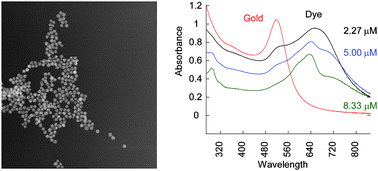The interaction between gold nanoparticles and cationic and anionic dyes: enhanced UV-visible absorption
Abstract
The interactions of charge stabilised

Maintenance work is planned for Wednesday 1st May 2024 from 9:00am to 11:00am (BST).
During this time, the performance of our website may be affected - searches may run slowly and some pages may be temporarily unavailable. If this happens, please try refreshing your web browser or try waiting two to three minutes before trying again.
We apologise for any inconvenience this might cause and thank you for your patience.
* Corresponding authors
a
Centre for Materials Research, Department of Chemistry, University College London, 20 Gordon Street, London, UK
E-mail:
i.p.parkin@uxl.ac.uk
Fax: +44 (0)20 7679 7463
Tel: +44 (0)20 7679 4669
b
Division of Microbial Diseases, UCL Eastman Dental Institute, University College London, 256 Gray’s Inn Road, London, UK
E-mail:
M.Wilson@eastman.ucl.ac.uk
Fax: +44 (0)20 7915 1127
Tel: +44 (0)20 7915 1050
The interactions of charge stabilised

 Please wait while we load your content...
Something went wrong. Try again?
Please wait while we load your content...
Something went wrong. Try again?
N. Narband, M. Uppal, C. W. Dunnill, G. Hyett, M. Wilson and I. P. Parkin, Phys. Chem. Chem. Phys., 2009, 11, 10513 DOI: 10.1039/B909714G
To request permission to reproduce material from this article, please go to the Copyright Clearance Center request page.
If you are an author contributing to an RSC publication, you do not need to request permission provided correct acknowledgement is given.
If you are the author of this article, you do not need to request permission to reproduce figures and diagrams provided correct acknowledgement is given. If you want to reproduce the whole article in a third-party publication (excluding your thesis/dissertation for which permission is not required) please go to the Copyright Clearance Center request page.
Read more about how to correctly acknowledge RSC content.
 Fetching data from CrossRef.
Fetching data from CrossRef.
This may take some time to load.
Loading related content
